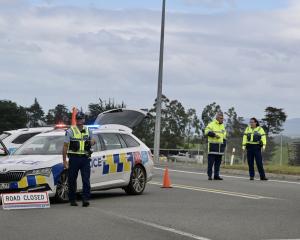The Dunedin City Council is still investigating possible causes for high lead levels in the water supply for Waikouaiti, Karitane and Hawksbury Village, but it believes three of the six intermittent elevated lead levels can likely be attributed to old, cast-iron pipes with lead fittings in the vicinity of Edinburgh St, Waikouaiti.
But using the piped water supply could be months away.
The announcement was made as hundreds of people packed into the East Otago Events Centre on a rainy Otago night to get an update on the issue.
Intermittent spikes in the level of lead, the highest almost 40 times the acceptable level, meant a no-drink notice was issued on February 2.
It remained in effect and could be in force for months.
Since then, several investigations and reviews have been launched and widespread blood testing carried out.
Medical officer of health Dr Susan Jack last night said nobody had a blood lead level that required hospitalisation, and very few exceeded the threshold.
"It appears long-term exposure to lead from the water supply is unlikely," she said.

Two children had levels above the new, lowered threshold of 0.24mol/L.
One had a strong reason for the level other than the water, while the second was still under investigation. Both would be followed up by a paediatrician.
Adults’ levels were also similar to the previous national survey.
Thirty-six had levels above the threshold, but almost all had other reasons to explain the higher lead level. Some were still being investigated.
Dr Jack
acknowledged the worry and concern in the community, reflected by the large number of people who got blood tests — 1512 people were tested.
Patterns were similar to those seen in other countries, she said.
Dunedin City Council chief executive Sandy Graham said 209 water samples had been taken since the Do Not Drink Notice was issued, returning results that showed lead either within acceptable limits or below detectable levels.
An accelerated programme to replace about 6.5km of old pipes in the area was under way, costing about $6million. Work began on February 15 and is estimated to be completed in June.
The work was already included in the council’s 10-year plan, but had been fast-tracked.
Other investigations into sources were also under way.
That included draining and testing sediment at the Waikouaiti raw water and Kiatoa reservoirs, which both supplied the affected communities. Both returned results well within acceptable standards, Ms Graham said.
Other possible sources of contamination suggested by the community were also being considered, including historic landfills in the vicinity of Edinburgh St and at the former Cherry Farm hospital site, the nearby Macraes mine, lead shot or fishing tackle in the catchment, or sampling or analytical errors.
"So far, no evidence pointing to these as a source of elevated lead levels has been found, but the investigation into some suggestions is continuing."
Council 3 Waters group manager Tom Dyer said the council was also investing in new technology for more rapid automated water sampling and results, including an online lead monitor from Belgium — believed to be a New Zealand first — and two new auto-samplers at the Waikouaiti water treatment plant.
Options and timeframes to re-establish a permanent drinking water supply varied depending on whether the source of the elevated lead levels was confirmed and addressed or not, and the type of solution settled on.
“We expect this could take at least two or three months, but we will keep the community updated as soon as we know more,” Mr Dyer said.
Dunedin Mayor Aaron Hawkins told last night’s meeting they might never have all of the answers, as it was a complex issue.
"I know people have been worried and upset," the mayor said.
"The health and wellbeing of our residents has always been our number one concern."
When asked by a member of the public last night about the wider issue of the taste and quality of the community’s water supply, Mr Hawkins said funds were allocated in the next year of the 10-year plan to upgrade the water treatment plant in Waikouaiti.
A question from a resident about whether the council would charge the community rates for its water supply drew one of the biggest rounds of applause of the night.
Ms Graham said there had been no consideration to rates changes because the council was still providing water to the community, albeit in a “less than ideal way".
Comments
I am curious to know why the USA was the country our blood level results were matched up with in last bights meeting, 1512 samples against how many Americans. Why not a group of similar size.












